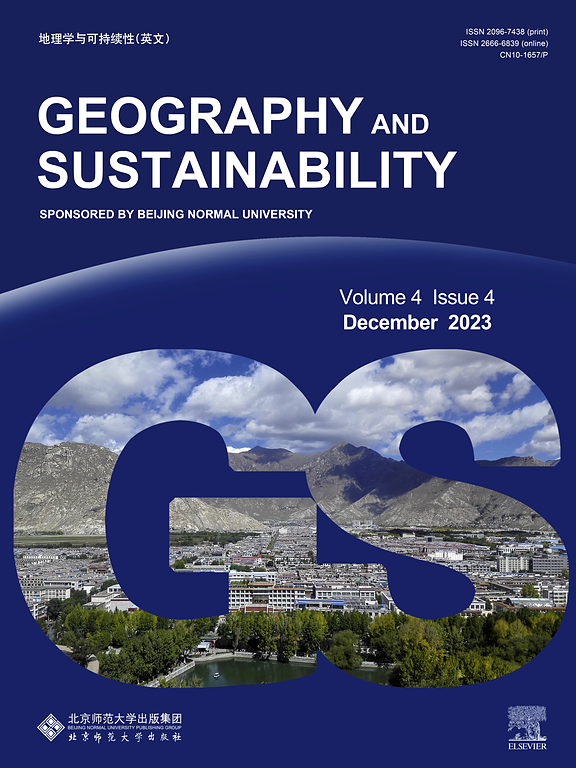Simulation of the future evolution track of “production–living–ecological” space in a coastal city based on multimodel coupling and wetland protection scenarios
IF 8
1区 环境科学与生态学
Q1 GEOGRAPHY, PHYSICAL
引用次数: 0
Abstract
Coastal cities hold a special position in the fields of production, living, and ecological research because of their unique wetland resource advantages. However, with global urbanization and rapid economic development, conflicts among production, living and ecological land are prevalent in coastal cities in the process of maintaining sustainable wetland resources and further developing the social economy. By establishing an SD-PLUS-CCD coupling model, this paper analysed the evolution characteristics and driving mechanism of the production–living–ecological space (PLES) and the effects of wetland protection (WLP) on promoting or inhibiting the coordinated development of the PLES in Dongying city during 2005–2060. The results show that (1) from 2005 to 2020, the increase in urban population resulted in a significant transfer of arable land and a reduction of 914 km2 in production space (PS); (2) from 2020 to 2060, under the WLP scenario, the conversion of wetland ecological space will reduce the PS and living space (LS) by 193.92 km2 and 107.14 km2, respectively, and increase the ecological space (ES) by 327.52 km2; and (3) wetland protection has an inhibitory effect on the coordinated development of PLES in the study area, and the total proportion of noncoordinated areas of PE and living–ecological space will continue to increase during the simulation period. This paper provides a solid theoretical support for the sustainable management and protection of wetlands in coastal cities and possible PLES conflict patterns and provides a scientific basis for future territorial spatial planning and policy balance analysis.

基于多模型耦合和湿地保护情景的滨海城市“生产-生活-生态”空间未来演化轨迹模拟
沿海城市以其独特的湿地资源优势,在生产、生活、生态研究等领域占有特殊地位。然而,随着全球城市化和经济的快速发展,沿海城市在维持湿地资源可持续发展和进一步发展社会经济的过程中,生产、生活和生态用地之间的矛盾普遍存在。通过建立SD-PLUS-CCD耦合模型,分析了2005-2060年东营市生产-生活-生态空间(PLES)的演化特征和驱动机制,以及湿地保护对东营市生产-生活-生态空间协调发展的促进或抑制作用。结果表明:①2005 - 2020年,城市人口增加导致耕地转移显著,生产空间减少914 km2;(2) 2020 - 2060年,湿地生态空间转换将使湿地PS和生存空间(LS)分别减少193.92 km2和107.14 km2,生态空间(ES)增加327.52 km2;(3)湿地保护对研究区生态空间协调发展具有抑制作用,模拟期间生态空间与生活生态空间不协调区域的总占比将继续增加。本文为滨海城市湿地的可持续管理和保护以及可能的生态系统冲突模式提供了坚实的理论支持,并为未来的国土空间规划和政策平衡分析提供了科学依据。
本文章由计算机程序翻译,如有差异,请以英文原文为准。
求助全文
约1分钟内获得全文
求助全文
来源期刊

Geography and Sustainability
Social Sciences-Geography, Planning and Development
CiteScore
16.70
自引率
3.10%
发文量
32
审稿时长
41 days
期刊介绍:
Geography and Sustainability serves as a central hub for interdisciplinary research and education aimed at promoting sustainable development from an integrated geography perspective. By bridging natural and human sciences, the journal fosters broader analysis and innovative thinking on global and regional sustainability issues.
Geography and Sustainability welcomes original, high-quality research articles, review articles, short communications, technical comments, perspective articles and editorials on the following themes:
Geographical Processes: Interactions with and between water, soil, atmosphere and the biosphere and their spatio-temporal variations;
Human-Environmental Systems: Interactions between humans and the environment, resilience of socio-ecological systems and vulnerability;
Ecosystem Services and Human Wellbeing: Ecosystem structure, processes, services and their linkages with human wellbeing;
Sustainable Development: Theory, practice and critical challenges in sustainable development.
 求助内容:
求助内容: 应助结果提醒方式:
应助结果提醒方式:


